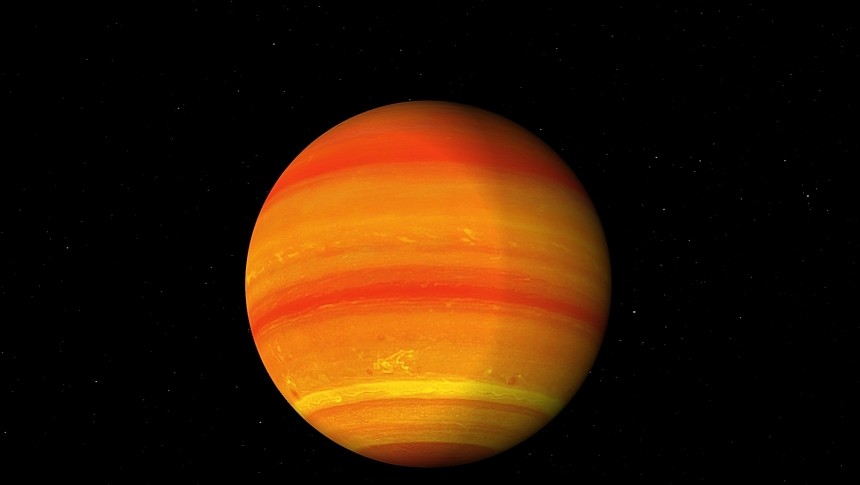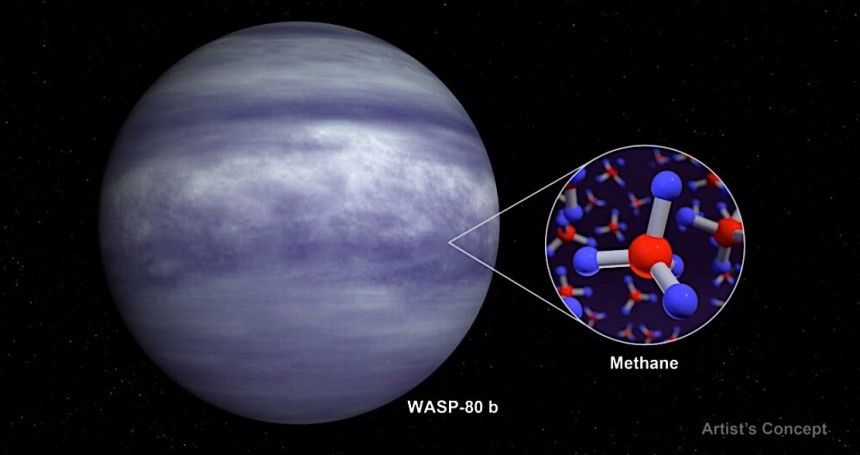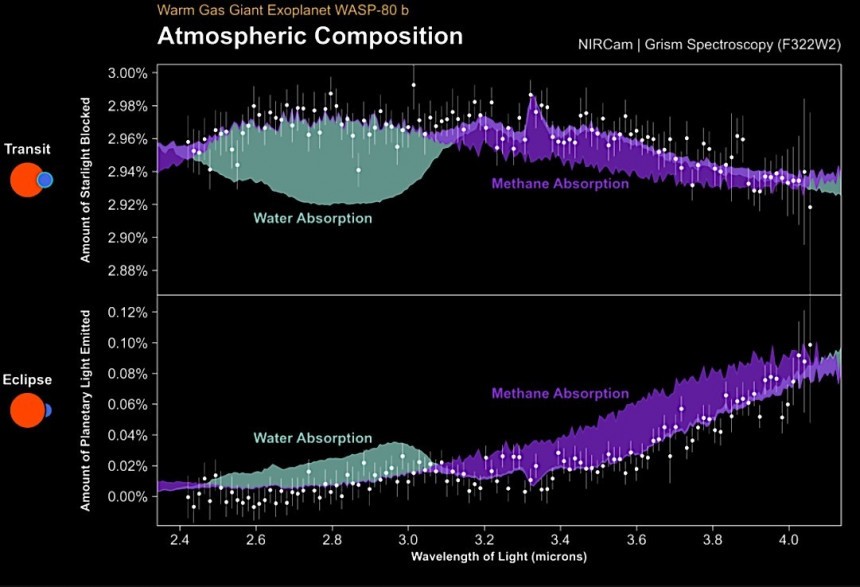Back in 2012 a planet called WASP-80 b was discovered in a constellation called Aquila. Just to give you some perspective, 163 light years away is the distance one would travel in 163 years while moving for the entire time at 186,000 miles per second (almost 300,000 km per second).
So, very, very far away by any measurable standard, but not even close to how far current telescopes, including the mighty James Webb, can see. That means knowing where planet WASP-80 b is does not come as such a big deal. But from that to finding it contains methane gas and water vapor in its atmosphere it's a huge leap forward, one that was just achieved with the help of the Webb.
You see, WASP-80 b is a planet about half the size, in terms of mass, of our own Jupiter, but almost just as large in terms of radius. That means it's incredibly tricky trying to determine what is there from so far away. Yet Webb, with help from Earth-based scientists and two research techniques known as the transit and eclipse methods, managed to discover just that.
More to the point, people from the NASA Ames Research Center and the Arizona State University tried to look at the distant planet while it passed both in front and behind its host star. This helped them uncover "spectra indicative of an atmosphere containing methane gas and water vapor."
The water part of the discovery is not particularly impressive, as the stuff has been found in the atmospheres of "over a dozen planets to date." Methane, on the other hand, although found in abundance on Jupiter, Saturn, Uranus, and Neptune, was tricky to spot on exoplanets located so far away, at least by means of space-based spectroscopy.
The presence of methane on WASP-80 b is not impressive in itself, but it is very important for future discoveries regarding the planet. Scientists will now move to measure how much methane and water there is in the atmosphere, and that will help them determine the ratio between carbon and oxygen atoms.
We know this ratio varies depending "on where and when planets form in their system," and in the case of WASP-80 b it could help us determine how close to its star the planet originally formed.
Knowing such a thing, along with a bunch of other aspects of the giant exoplanet, will help us get a better understanding of our solar system's own planets, especially the gas giants, work. True, we do know a lot about them, but to date we have been unable to compare them to similar celestial bodies located elsewhere.
This kind of comparative look will give us a proper picture of such bodies, and either prove or disprove some of the theories and certainties we have about them.
The plan is to have Webb trained on WASP-80 b some more. Aside from trying to determine the ratio between carbon and oxygen atoms, the goal is now to probe the planet's atmosphere at different wavelengths of light.
This will allow us, combined with an analysis of the place's chemical composition, to learn more about how this distant world was born, grew, and evolved. The scientists who are working on this say they expect to find other carbon-rich molecules there, including carbon monoxide and carbon dioxide.
There are a number of things we already know about the planet. We've seen it orbiting its red dwarf star once every three days, meaning it's extremely close to it. Closer, in fact, than Mercury is to our own star.
The star is known as WASP-80 and was nicknamed Petra in 2019 at the end of the NameExoWorlds competition.
The sun itself is a K-type star that's a lot younger than our own beacon of light, and so far we know of only this single planet doing circles around it.
We also know the planet has a temperature of about 1,025 degrees Fahrenheit (552 degrees Celsius), making it incompatible with life as we know it. The planet is considered as a result of its temperature a warm Jupiter.
That would be a planet that is relatively similar in size and mass to our own gas giant, but it's situated, temperature-wise, somewhat in the middle of spectrum. For reference, exoplanets known as hot Jupiters burn at 2,150 degrees Fahrenheit (1,177 degrees Celsius), while the cold ones come in at just 235 degrees Fahrenheit, meaning 113 degrees Celsius.
As for its name, like other exoplanets we've been able to find out there, 80 b takes the WASP particle after the Wide Angle Search for Planets project born in 1999. It's an effort that so far led to the discovery of some 150 planets, making this effort second only to the Kepler mission.
The recent methane and water findings on WASP-80 b with the help of the James Webb Space Telescope were published recently in Nature.
You see, WASP-80 b is a planet about half the size, in terms of mass, of our own Jupiter, but almost just as large in terms of radius. That means it's incredibly tricky trying to determine what is there from so far away. Yet Webb, with help from Earth-based scientists and two research techniques known as the transit and eclipse methods, managed to discover just that.
More to the point, people from the NASA Ames Research Center and the Arizona State University tried to look at the distant planet while it passed both in front and behind its host star. This helped them uncover "spectra indicative of an atmosphere containing methane gas and water vapor."
The water part of the discovery is not particularly impressive, as the stuff has been found in the atmospheres of "over a dozen planets to date." Methane, on the other hand, although found in abundance on Jupiter, Saturn, Uranus, and Neptune, was tricky to spot on exoplanets located so far away, at least by means of space-based spectroscopy.
The presence of methane on WASP-80 b is not impressive in itself, but it is very important for future discoveries regarding the planet. Scientists will now move to measure how much methane and water there is in the atmosphere, and that will help them determine the ratio between carbon and oxygen atoms.
We know this ratio varies depending "on where and when planets form in their system," and in the case of WASP-80 b it could help us determine how close to its star the planet originally formed.
This kind of comparative look will give us a proper picture of such bodies, and either prove or disprove some of the theories and certainties we have about them.
The plan is to have Webb trained on WASP-80 b some more. Aside from trying to determine the ratio between carbon and oxygen atoms, the goal is now to probe the planet's atmosphere at different wavelengths of light.
This will allow us, combined with an analysis of the place's chemical composition, to learn more about how this distant world was born, grew, and evolved. The scientists who are working on this say they expect to find other carbon-rich molecules there, including carbon monoxide and carbon dioxide.
There are a number of things we already know about the planet. We've seen it orbiting its red dwarf star once every three days, meaning it's extremely close to it. Closer, in fact, than Mercury is to our own star.
The star is known as WASP-80 and was nicknamed Petra in 2019 at the end of the NameExoWorlds competition.
We also know the planet has a temperature of about 1,025 degrees Fahrenheit (552 degrees Celsius), making it incompatible with life as we know it. The planet is considered as a result of its temperature a warm Jupiter.
That would be a planet that is relatively similar in size and mass to our own gas giant, but it's situated, temperature-wise, somewhat in the middle of spectrum. For reference, exoplanets known as hot Jupiters burn at 2,150 degrees Fahrenheit (1,177 degrees Celsius), while the cold ones come in at just 235 degrees Fahrenheit, meaning 113 degrees Celsius.
As for its name, like other exoplanets we've been able to find out there, 80 b takes the WASP particle after the Wide Angle Search for Planets project born in 1999. It's an effort that so far led to the discovery of some 150 planets, making this effort second only to the Kepler mission.
The recent methane and water findings on WASP-80 b with the help of the James Webb Space Telescope were published recently in Nature.








